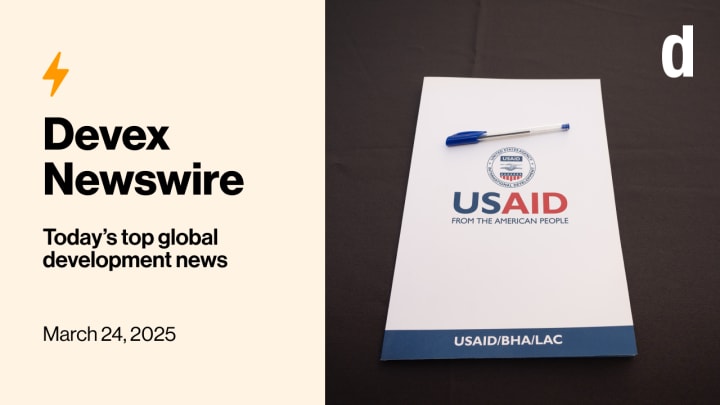
Yesterday we revealed the USAID programs that survived the Trump administration’s aid freeze, and those that didn’t make the cut. We have now gone line by line (thousands of them) to put meat on the bone and present
Is it too soon to move on from the slash-and-burn phase of the U.S. aid cuts? Meanwhile, over in the U.K., the Brits are dealing with (bad) timing of a different sort.
It’s been a labor of love: Dissecting reams of Excel entries from the most official list — to date — that we have of ’s bruised-and-battered roster of programs.
Sign up to this newsletter for an inside look at the biggest stories in global development, in your inbox daily.
Granted, “love” is hardly the term the aid community would use to describe the results, which largely that the Trump administration has taken to foreign aid. But perhaps there’s some power in at least knowing, one way or another, after two months of confusion and chaos — although I highly doubt this list is the end of it.
So, we’ll continue to bring you updated analyses boring into the data and what it means on a practical level. For now, be sure to check out (and bookmark) the continuation of our initial breakdown, which offers , including:
• The state of America’s global health contributions, from Gavi, the Vaccine Alliance, to the World Health Organization, to the Global Fund to Fight AIDS, Tuberculosis and Malaria.
• The more than 180 severed awards to USAID programs run by United Nations agencies, including the International Organization for Migration, the United Nations Development Programme, and the Food and Agriculture Organization.
• On the flip side, the awards retained for U.N. agencies such as the World Food Programme and the U.N. Office for the Coordination of Humanitarian Affairs.
• The winning and losing programs among contracting giants such as Chemonics, Tetra Tech, and Credence Management Solutions.
The USAID awards the Trump administration killed — and kept
Who lost the most? The 20 USAID contractors hit hardest (Pro)
For the latest episode of our podcast series, Devex’s David Ainsworth, Adva Saldinger, and Colum Lynch dig into the ins and outs of the data to assess the true scope of the U.S. aid cuts.
Is it time to and move on — hopefully to more stability and overdue reform? Or are we doing everyone a disservice by trying to hastily put that past behind us? Is it even possible amid ongoing turbulence?
Those were some of the central questions asked by a panel of experts, of all political stripes, at a recent Devex Pro briefing, where what comes next was a hotly debated topic.
“We can talk about how this change was done. Was it right? Was it too blunt? We can all argue about that. What I tried to do is ,” said former U.S. Rep. Ted Yoho, a Florida Republican. “Let’s get back to honoring the contracts that were canceled. Let’s where they need to be, and get rid of the nonsense in some of these programs. And I think if we do that, you're going to see this move rather quickly.”
Not so fast, countered Lisa Bos of InterAction.
“We have lost expertise and staff, not just at USAID, but in some of these countries where you had locally employed staff at NGOs who are not going to come back,” she said. “So I think whatever comes next, there has to be an acknowledgement that
What’s left, but more importantly, what’s ahead for USAID? (Pro)
+ Start your 15-day free trial today to access all our expert analyses, insider insights, funding data, exclusive events and career resources, and the Pro Insider — a special Sunday newsletter covering our industry’s big moves for Pro members.
You may have heard that the United Kingdom plans to cut its aid budget from 0.5% of gross national income to 0.3%. Well now, according to a letter sent from Development Minister Jenny Chapman yesterday, it will no longer be linked to national income at all, instead having a fixed budget.
“The [Foreign, Commonwealth & Development Office] or [official development assistance] spending by other departments, including demand-driven indonor refugee costs, thereby increasing the predictability of our budgets and allowing us to plan with more certainty.”
While the U.K. Parliament’s International Development Committee chair Sarah Champion said this — getting in-donor refugee costs out of the aid budget has been a constant ask from the U.K. aid community — she also said she’s made “very nervous” by the change.That’s probably not helped by Chapman’s announcement that this year’s aid spending will only meet existing commitments, plus full planned allocations for Ukraine, Sudan, Palestinian territories, and British overseas territories. Oh, and a £100 million ($129.4 million) crisis fund.
One thing both the U.K. and U.S. aid cuts seem to have in common is that the public In the U.S., voters consistently assume aid makes up a large chunk of federal spending (for the umpteenth time, it doesn’t) and therefore tend to cheer on cuts.
Likewise, across the pond, the cuts have proven broadly popular with the public, writes Jessica Abrahams for Devex. A YouGov survey earlier this month found that in order to boost defense spending, and that support existed among voters across all the main parties.
UK opts to disconnect development from gross national income
Inside the UK aid cuts — what will the 0.3% budget cover? (Pro)
6 lessons for the US from the UK's aid department's traumatic demise
+ for a conversation with Simon Meier, the head of BII Plus at British International Investment to better understand how to engage with the U.K.’s development finance institution and the opportunities that technical assistance can offer as a critical investment tool. Register now.
The Nutrition for Growth, or N4G, summit in Paris, France, worldwide, French President Emmanuel Macron announced yesterday afternoon. It broke the record set at the previous summit in Tokyo, Japan, in 2021, with more pledges trickling in.
And it’s despite a difficult environment for fundraising, with foreign aid cuts by several Western donors including the United States, United Kingdom, and even the N4G host country. — in 2021 it had pledged $13 million — and the U.K., which hosted the first N4G summit in 2012, did not make a financial commitment but co-launched a coalition on integrating nutrition across sectors. France, the host country, pledged to spend more than $750 million on tackling malnutrition by 2030. A finalized list of pledges is due out later today.
The other big news yesterday was an announcement by a group of philanthropies that Among them were the Gates Foundation, which committed $750 million; the Rockefeller Foundation, which committed $100 million toward school meals; the Bezos Family Foundation, which pledged to match $500 million in donations to the Child Nutrition Fund; the Eleanor Crook Foundation, which pledged up to $50 million toward scaling up prenatal vitamins; the Asia Venture Philanthropy Network with $10 million; and others.
+ For more content like this, sign up to Devex Dish, a weekly newsletter on the transformation of the global food system.
The White House yesterday to be U.S. ambassador to the United Nations amid fear her departure could weaken the Republican Party’s thin majority in the House of Representatives.
The move as the Trump administration is carrying out large-scale cuts across the world body, ending U.S. participation in the U.N. Human Rights Council and severing funding for the U.N. main agency for Palestinian refugees, or UNRWA. On Feb. 4, Trump also ordered a 180-day review of all international organizations, including the United Nations, to determine whether their activities advance U.S. interests.
An investigation into whether laws were breached in is underway in Italy. [The Guardian]
South Africa plans to revitalize eight of its biggest cities with $1 billion support from the World Bank. [Bloomberg]
Myanmar was hit by a 7.7 magnitude earthquake, with tremors also felt in neighboring Thailand. [Reuters]
Sign up to Newswire for an inside look at the biggest stories in global development.












